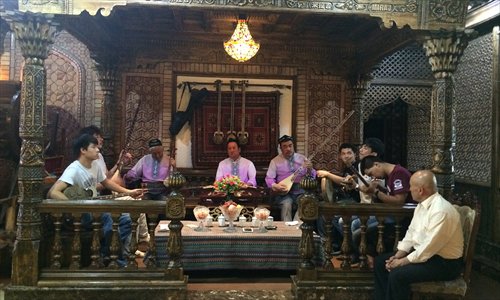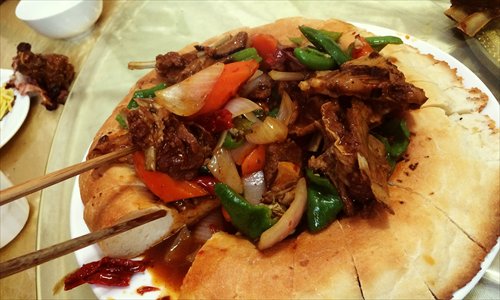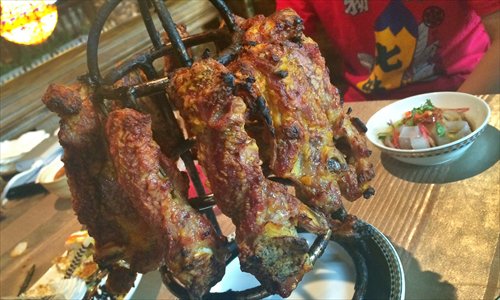HOME >> LIFE
Meat & Drink
By Li Jingjing in Urumqi Source:Global Times Published: 2014-9-19 5:03:01
Fill yourself with delicacies from Xinjiang

Local Uyghur performers play instruments in local Xinjiang restaurant Miraj. Photo: Li Jingjing/GT

Stewed beef on naan bread Photo: Li Jingjing/GT

Roast muttons hanging on a wire frame Photo: Li Jingjing/GT
When it comes to TV shows that portray the life of people in the Xinjiang Uyghur Autonomous Region, the images of people from all ages dancing traditional Uyghur dances, while delicacies are lined up on a table behind them are the ones that are most memorable for me.As I approached the door to Miraj, a chain restaurant in Urumqi, capital of Xinjiang, the sound of bouncy and charming Uyghur music could be heard drifting through the door. Entering the building and walking up dark brown wooden stairs with exquisite carvings on it, I reached the central hall, where the music was coming from. Entering the hall, the image that I was used to seeing on TV suddenly leapt out right in front of me. A bunch of local people were playing Uyghur instruments, like the Dongbula, tambourine and some others that I couldn't even name. What surprised me the most were the dancers, dressed in bright green ethnic clothes, they were two old men with moustaches dancing all around the hall. From their passion for music and dance at even their age, I could see how music and dance are in the Uyghur people's blood.
This jovial scene, put me in a great mood, and I was totally ready to enjoy the feast. Thoughts of Xinjiang's famous kebabs, loved by everyone and long a favorite throughout China, floated through my head.
However, I soon found there is so much more besides kebabs in Xinjiang.
Fruit medley
No matter where I went to eat in Xinjiang, two types of food were always recommended, mutton and fruit. What's so special about fruit in Xinjiang? Well for starters, all the fruit I tried was amazingly sweet and juicy. Far better than the watermelon, apricots and grapes back in the eastern part of China.
A friend explained that due to the region's unique geographic location, plants here enjoy ample sunshine; coupled with large temperature differences between day and night, this helps fruit accumulate more sugar. A common mainstay, every family I ate with offered fruit and mutton to show their hospitality.
If you don't want to fill up on fruit before you bite into a tasty kebab, then I recommend trying a fruity beverage instead. Pomegranate juice soon shot to the top of my favorites list. When I first ordered it from the menu, I didn't have very high expectations, but once I tried it I realized it was totally different from any other freshly squeezed juice that I tried before. I could tell that little water had been added by my drink's deep bright red color, and it tasted amazingly sour.
Another sour drink that I'll remember for the rest of my life is Xinjiang yogurt. They served it in a small bowl with a wooden spoon. It was really thick, so "drink" may not be the most appropriate word since it was almost solid. Since I like to add vinegar whenever I eat noodles or soup, I thought I wouldn't have any problem handling any sourness that the yogurt could throw my way, but the level of sourness flew right by my normal limits. In the end I had to add two spoonfuls of sugar before I could continue to enjoy it.
I could feel the yogurt melting the insides of my stomach. Just as I was starting to wonder why they would make it so sour, our kebabs arrived and I suddenly knew why: With all this meat, I would need something to help my digestion.
Hearty main course
Xinjiang probably has the best mutton and the best way to cook it in the entire world. We of course ordered several helpings of kebabs, or as many people call them in Beijing, chuaner. Sprinkled with pepper and cumin, the kebabs were more authentic, tastier and bigger than those found in restaurants in other cities.
It turns out these were just the appetizers, as the waiter began bringing in even more meat. One of the dishes which involved hanging huge chunks of mutton on a wire frame and then roasting the meat in a stove quickly became my favorite. With the full power of the fire, the meat was transformed into a delicacy with a crispy outside and a tender inside. As the waiter put all this tempting food in front of me, I soon forgot all about courtesies. I had originally tried to use chopsticks in order to be polite, but it was really hard to grasp such huge pieces of meat that way. In the end, I just used my bare hands tear into everything, forgetting completely my manners as a lady.
I never knew there was so many ways to cook mutton. In a different restaurant, I tried another typical Xinjiang course that's eaten with just your hands. It's basically boiled mutton and bones, with a pile of chopped onions thrown in. It's certainly a great chance to enjoy the natural smell of mutton, if you can stand the strong smell that is.
Of course no meal is complete without some side dishes. One common food item is the local flatbread known as naan. Naan bread is big round and very dry. A local staple it can be found everywhere in Xinjiang. It's said that back before modern transportation, local people would sometimes have to spend months riding on donkeys or camels through deserts such as the Gobi Desert to reach other cities. Dry naan bread was the perfect food for such journeys as it can last a long time without going bad.
This tradition still has its uses even today. When we traveled from Urumqi to the very north border of Xinjiang by mini coach, our driver stopped and bought two piles of naan bread to store in the car. If you find the bread too dry, a great way to enjoy naan is to pour the stew from mutton or beef on the naan to soften it up.
For those who love noodles, why not try some laghman? Instead of soup, these local noodles are covered with pieces of cooked meat and vegetables. Stir it up before eating, and you certainly won't regret your choice.
Posted in: Food